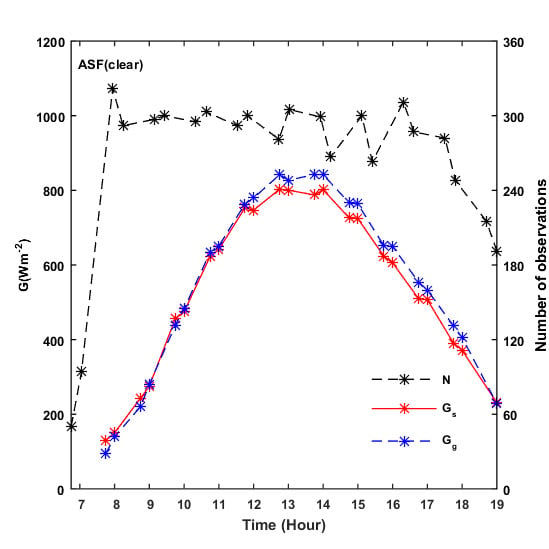An Evaluation of Satellite Estimates of Solar Surface Irradiance Using Ground Observations in San Antonio, Texas, USA
Abstract
1. Introduction
2. Data
2.1. Satellite Estimates
2.2. Ground Observations
3. Method
4. Results
4.1. Descriptive Statistics of Cloud Occurrence and Surface Solar Irradiance
4.2. Comparison of Gs and Gg on Hourly and Daily Timescales under All Sky Conditions
4.3. Comparison of Gs and Gg on an Hourly Timescale under Clear-Sky and Cloudy-Sky Conditions
4.4. Comparison of Gs and Gg on an Hourly Timescale under Different Cloud Types and Layers
4.5. Comparison of Gs and Gg on an Hourly Timescale Under Different Solar Zenith Angles
5. Discussion
6. Conclusions
Acknowledgments
Author Contributions
Conflicts of Interest
References
- Bahnemann, D. Photocatalytic water treatment: Solar energy applications. Sol. Energy 2004, 77, 445–459. [Google Scholar] [CrossRef]
- Malato, S.; Maldonado, M.I.; Fernandez-Ibanez, P.; Oller, I.; Polo, I.; Sanchez-Moreno, R. Decontamination and disinfection of water by solar photocatalysis: The pilot plants of the Plataforma Solar de Almeria. Mater. Sci. Semicond. Process. 2016, 42, 15–23. [Google Scholar] [CrossRef]
- Byrne, J.A.; Fernandez-Ibanez, P.A.; Dunlop, P.S.M.; Alrousan, D.M.A.; Hamilton, J.W.J. Photocatalytic Enhancement for Solar Disinfection of Water: A Review. Int. J. Photoenergy 2011. [Google Scholar] [CrossRef]
- Jasrotia, S.; Kansal, A.; Kishore, V.V.N. Application of solar energy for water supply and sanitation in Arsenic affected rural areas: A study for Kaudikasa village, India. J. Clean. Prod. 2013, 60, 102–106. [Google Scholar] [CrossRef]
- Samimi, A.; Zarinabadi, S.; Samimi, M. Solar Energy Application on Environmental Protection. Int. J. Sci. Investig. Fr. 2012, 1, 21–24. [Google Scholar]
- Novacheck, J.; Johnson, J.X. The environmental and cost implications of solar energy preferences in Renewable Portfolio Standards. Energy Policy 2015, 86, 250–261. [Google Scholar] [CrossRef]
- Hernandez, R.R.; Easter, S.B.; Murphy-Mariscal, M.L.; Maestre, F.T.; Tavassoli, M.; Allen, E.B.; Barrows, C.W.; Belnap, J.; Ochoa-Hueso, R.; Ravi, S.; et al. Environmental impacts of utility-scale solar energy. Renew. Sustain. Energy Rev. 2014, 29, 766–779. [Google Scholar] [CrossRef]
- Hosseini, S.E.; Andwari, A.M.; Wahid, M.A.; Bagheri, G. A review on green energy potentials in Iran. Renew. Sustain. Energy Rev. 2013, 27, 533–545. [Google Scholar] [CrossRef]
- Abas, N.; Kalair, A.; Khan, N. Review of fossil fuels and future energy technologies. Futures 2015, 69, 31–49. [Google Scholar] [CrossRef]
- Pinker, R.T.; Laszlo, I.; Tarpley, J.D.; Mitchell, K. Geostationary satellite parameters for surface energy balance. Adv. Space Res. 2002, 30, 2427–2432. [Google Scholar] [CrossRef]
- Laszlo, I.; Ciren, P.; Liu, H.; Kondragunta, S.; Tarpley, J.D.; Goldberg, M.D. Remote sensing of aerosol and radiation from geostationary satellites. Adv. Space Res. 2008, 41, 1882–1893. [Google Scholar] [CrossRef]
- Pinker, R.T.; Ewing, J. Modeling surface solar radiation: Model formulation and validation. J. Clim. Appl. Meteorol. 1985, 24, 389–401. [Google Scholar] [CrossRef]
- Pinker, R.T.; Tarpley, J.D.; Laszlo, I.; Mitchell, K.E.; Houser, P.R.; Wood, E.F.; Schaake, J.C.; Robock, A.; Lohmann, D.; Cosgrove, B.A.; et al. Surface radiation budgets in support of the GEWEX Continental-Scale International Project (GCIP) and the GEWEX Americas Prediction Project (GAPP), including the North American Land Data Assimilation System (NLDAS) project: GEWEX Continental-Scale International Project, Part 3 (GCIP3). J. Geophys. Res. 2003, 108. [Google Scholar] [CrossRef]
- Augustine, J.A.; DeLuisi, J.J.; Long, C.N. SURFRAD—A national surface radiation budget network for atmospheric research. Bull. Am. Meteorol. Soc. 2000, 81, 2341–2357. [Google Scholar] [CrossRef]
- Meng, C.J.; Pinker, R.T.; Tarpley, J.D.; Laszlo, I. A satellite approach for estimating regional land surface energy budget for GCIP/GAPP. J. Geophys. Res. 2003, 108. [Google Scholar] [CrossRef]
- Otkin, J.A.; Anderson, M.C.; Mecikalski, J.R.; Diak, G.R. Validation of GOES-based insolation estimates using data from the US Climate Reference Network. J. Hydrometeorol. 2005, 6, 460–475. [Google Scholar] [CrossRef]
- Habte, A.; Sengupta, M.; Wilcox, S. Comparing Measured and Satellite-Derived Surface Irradiance. In Proceedings of the ASME 2012 6th International Conference on Energy Sustainability collocated with the ASME 2012 10th International Conference on Fuel Cell Science, Engineering and Technology, San Diego, CA, USA, 23–26 July 2012; pp. 561–566. [Google Scholar]
- Habte, A.; Sengupta, M.; Wilcox, S. Validation of GOES-Derived Surface Radiation Using NOAA’s Physical Retrieval Method; Technical Report NREL/TP-5500-57442; National Renewable Energy Laboratory: Golden, CO, USA, 2013. [CrossRef]
- Zidanšek, A.; Ambrožič, M.; Milfelner, M.; Blinc, R.; Lior, N. Solar orbital power: Sustainability analysis. Energy 2011, 36, 1986–1995. [Google Scholar] [CrossRef]
- Escrig, H.; Batlles, F.J.; Alonso, J.; Baena, F.M.; Bosch, J.L.; Salbidegoitia, I.B.; Burgaleta, J.I. Cloud detection, classification and motion estimation using geostationary satellite imagery for cloud cover forecast. Energy 2013, 55, 853–859. [Google Scholar] [CrossRef]
- Kleissl, J. Solar Energy Forecasting and Resource Assessment; Academic Press: Cambridge, MA, USA, 2013; pp. 50–76. [Google Scholar]
- Pinker, R.T.; Laszlo, I. Modeling surface solar irradiance for satellite applications on a global scale. J. Appl. Meteorol. 1992, 31, 194–211. [Google Scholar] [CrossRef]
- Pinker, R.T.; Laszlo, I. Global distribution of photosynthetically active radiation as observed from satellites. J. Clim. 1992, 5, 56–65. [Google Scholar] [CrossRef]
- Mesinger, F.; Black, T.L. On the impact on forecast accuracy of the step-mountain (eta) vs. sigma coordinate. Meteorol. Atmos. Phys. 1992, 50, 47–60. [Google Scholar] [CrossRef]
- Black, T.L. The new NMC mesoscale Eta model: Description and forecast examples. Weather Forecast. 1994, 9, 265–278. [Google Scholar] [CrossRef]
- Tarpley, J.D.; Pinker, R.T.; Laszlo, I. Experimental GOES shortwave radiation budget for GCIP. In Proceedings of the Second International Scientific Conference on the Global Energy and Water Cycle, Washington, DC, USA, 17–21 June 1996; pp. 17–21. [Google Scholar]
- Rogers, E.; Black, T.L.; Deaven, D.G.; DiMego, G.J.; Zhao, Q.; Baldwin, M.; Junker, N.W.; Lin, Y. Changes to the operational “early” Eta analysis/forecast system at the National Centers for Environmental Prediction. Weather Forecast. 1996, 11, 391–413. [Google Scholar] [CrossRef]
- Stephens, G.L.; Ackerman, S.; Smith, E.A. A shortwave parameterization revised to improve cloud absorption. J. Atmos. Sci. 1984, 41, 687–690. [Google Scholar] [CrossRef]
- Lave, M.; Kleissl, J. Optimum fixed orientations and benefits of tracking for capturing solar radiation in the continental United States. Renew. Energy 2011, 36, 1145–1152. [Google Scholar] [CrossRef]
- Pavolonis, M.J.; Heidinger, A.K.; Uttal, T. Daytime global cloud typing from AVHRR and VIIRS: Algorithm description, validation, and comparisons. J. Appl. Meteorol. 2005, 44, 804–826. [Google Scholar] [CrossRef]
- Reno, M.J.; Stein, J.S. Using cloud classification to model solar variability. In Proceedings of the ASES National Solar Conference, Baltimore, MD, USA, 16–20 April 2013. [Google Scholar]
- Vignola, F.; Michalsky, J.; Stoffel, T. Solar and Infrared Radiation Measurements; CRC Press: Boca Raton, FL, USA, 2016. [Google Scholar]
- Mellit, A.; Pavan, A.M. A 24-h forecast of solar irradiance using artificial neural network: Application for performance prediction of a grid-connected PV plant at Trieste, Italy. Sol. Energy 2010, 84, 807–821. [Google Scholar] [CrossRef]
- Stephens, G.L. Radiation profiles in extended water clouds. I: Theory. J. Atmos. Sci. 1978, 35, 2111–2122. [Google Scholar] [CrossRef]
- Jang, J.; Lee, C.; Hahn, J.W. Theoretical study on evaporation of sessile water droplets on a glass panel with infrared radiation. J. Mech. Sci. Technol. 2014, 28, 1575–1580. [Google Scholar] [CrossRef]
- Fan, J.W.; Leung, L.R.; Rosenfeld, D.; DeMott, P.J. Effects of cloud condensation nuclei and ice nucleating particles on precipitation processes and supercooled liquid in mixed-phase orographic clouds. Atmos. Chem. Phys. 2017, 17, 1017–1035. [Google Scholar] [CrossRef]
- Cintineo, J.L.; Pavolonis, M.J.; Sieglaff, J.M.; Heidinger, A.K. Evolution of Severe and Nonsevere Convection Inferred from GOES-Derived Cloud Properties. J. Appl. Meteorol. Climatol. 2013, 52, 2009–2023. [Google Scholar] [CrossRef]
- Kayetha, V.K. Ice Clouds over Fairbanks, Alaska. Master’s Thesis, University of Alaska Fairbanks, Fairbanks, AK, USA, 2014. [Google Scholar]
- Martin, J. Wild Weather (Oxford Read and Discover Level 5); Oxford University Press: Oxford, UK, 2015. [Google Scholar]
- Qu, Z.; Oumbe, A.; Blanc, P.; Espinar, B.; Gesell, G.; Gschwind, B.; Klüser, L.; Lefèvre, M.; Saboret, L.; Schroedter-Homscheidt, M.; et al. Fast radiative transfer parameterisation for assessing the surface solar irradiance: The Heliosat-4 method. Meteorologische Zeitschrift 2017, 26, 33–57. [Google Scholar] [CrossRef]
- Bengulescu, M.; Blanc, P.; Boilley, A.; Wald, L. Do modelled or satellite-based estimates of surface solar irradiance accurately describe its temporal variability? Adv. Sci. Res. 2017, 14, 35–48. [Google Scholar] [CrossRef]
- Masuda, K. Surface radiation budget: Comparison between global satellite-derived products and land-based observations in Asia and Oceania. In Proceedings of the International Radiation Symposium, Busan, Korea, 23–28 August 2014. [Google Scholar]
- Eissa, Y.; Korany, M.; Aoun, Y.; Boraiy, M.; Abdel Wahab, M.M.; Alfaro, S.C.; Blanc, P.; EI_Metwally, M.; Ghedira, H.; Hungershoeder, K.; et al. Validation of the surface downwelling solar irradiance estimates of the HelioClim-3 database in Egypt. Remote Sens. 2015, 7, 9269–9291. [Google Scholar] [CrossRef]
- Marie-Joseph, I.; Linguet, L.; Gobinddass, M.L.; Wald, L. On the applicability of the Heliosat-2 method to assess surface solar irradiance in the Intertropical Convergence Zone, French Guiana. Int. J. Remote Sens. 2013, 34, 3012–3027. [Google Scholar] [CrossRef]


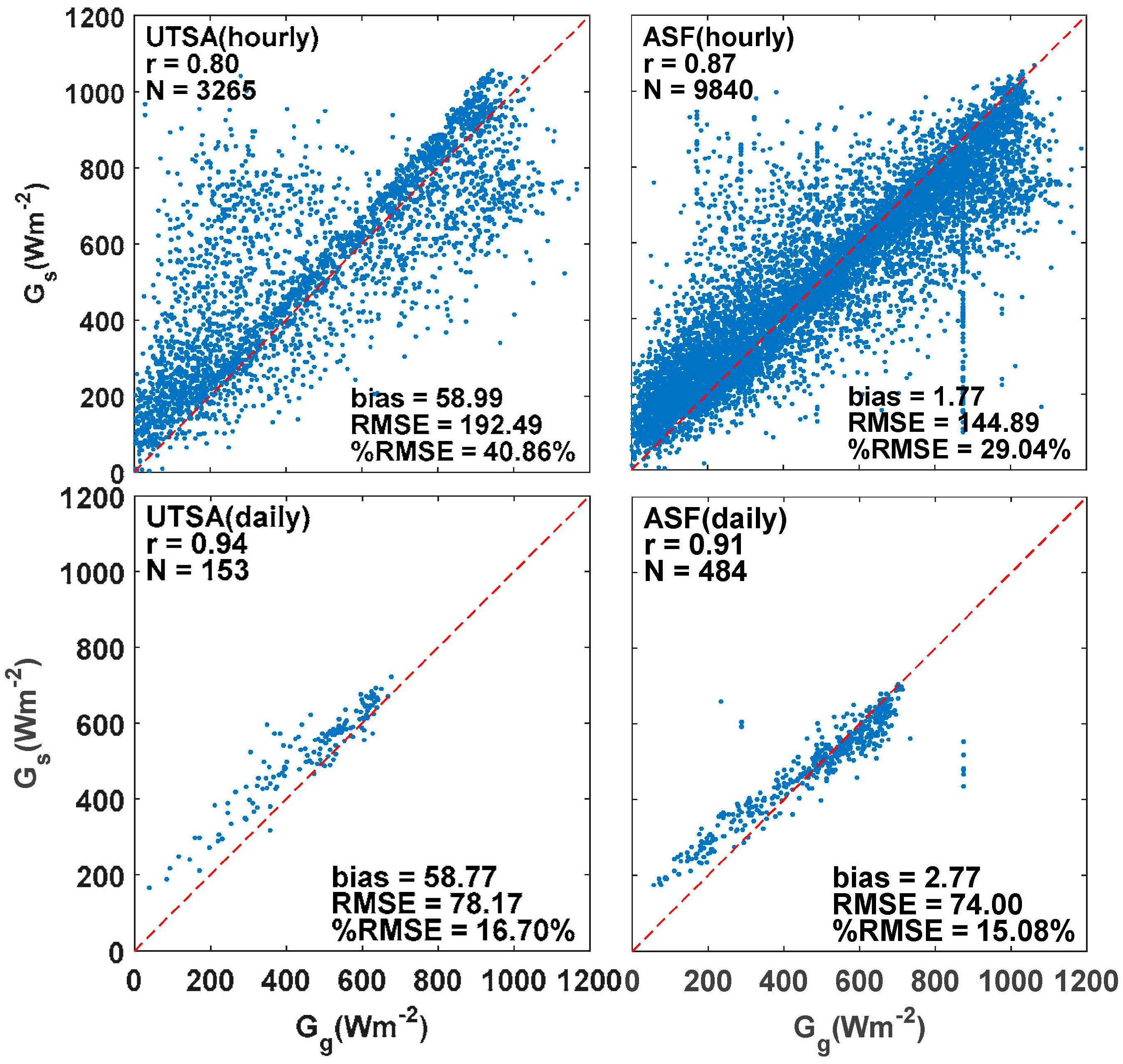

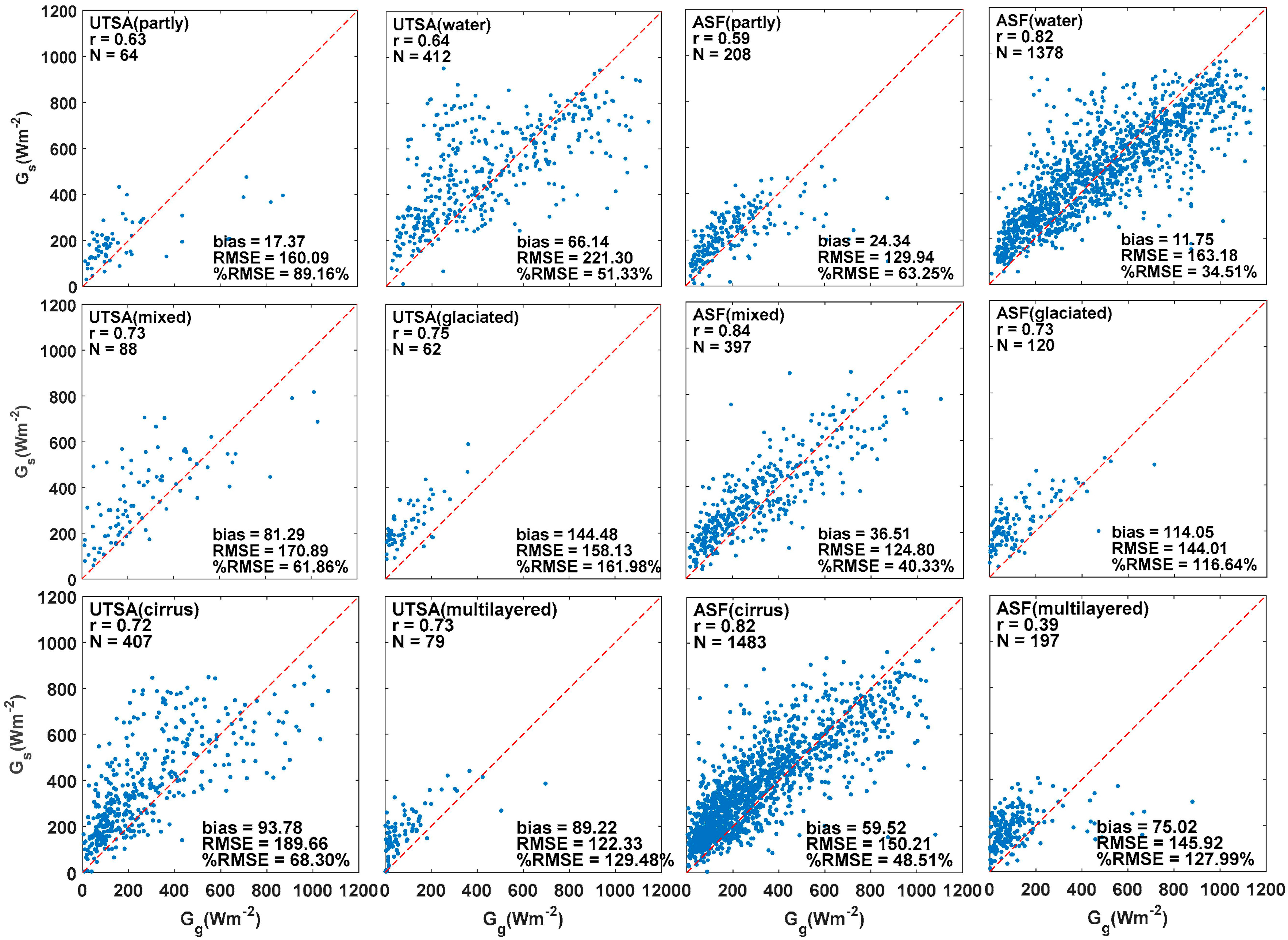
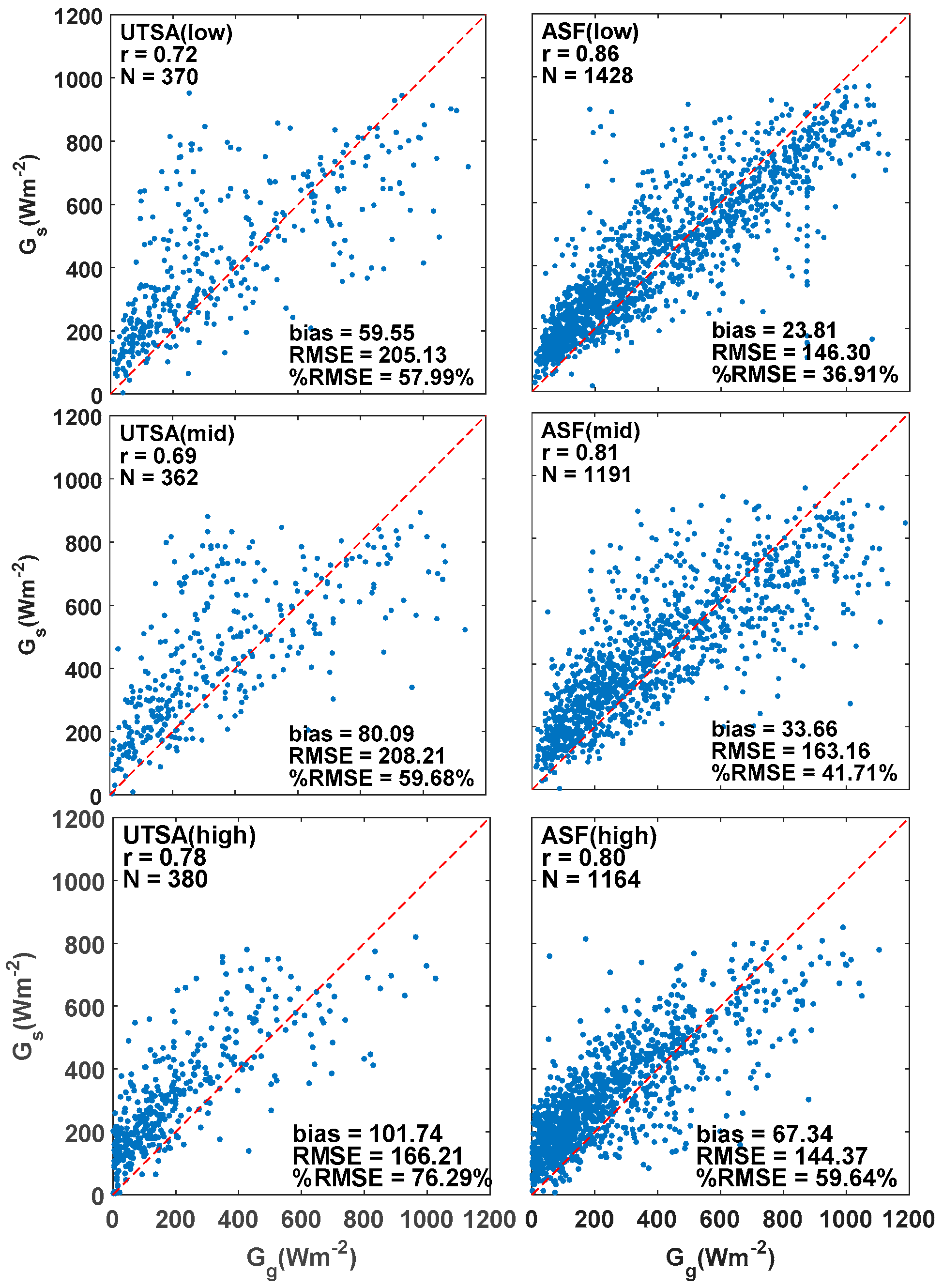
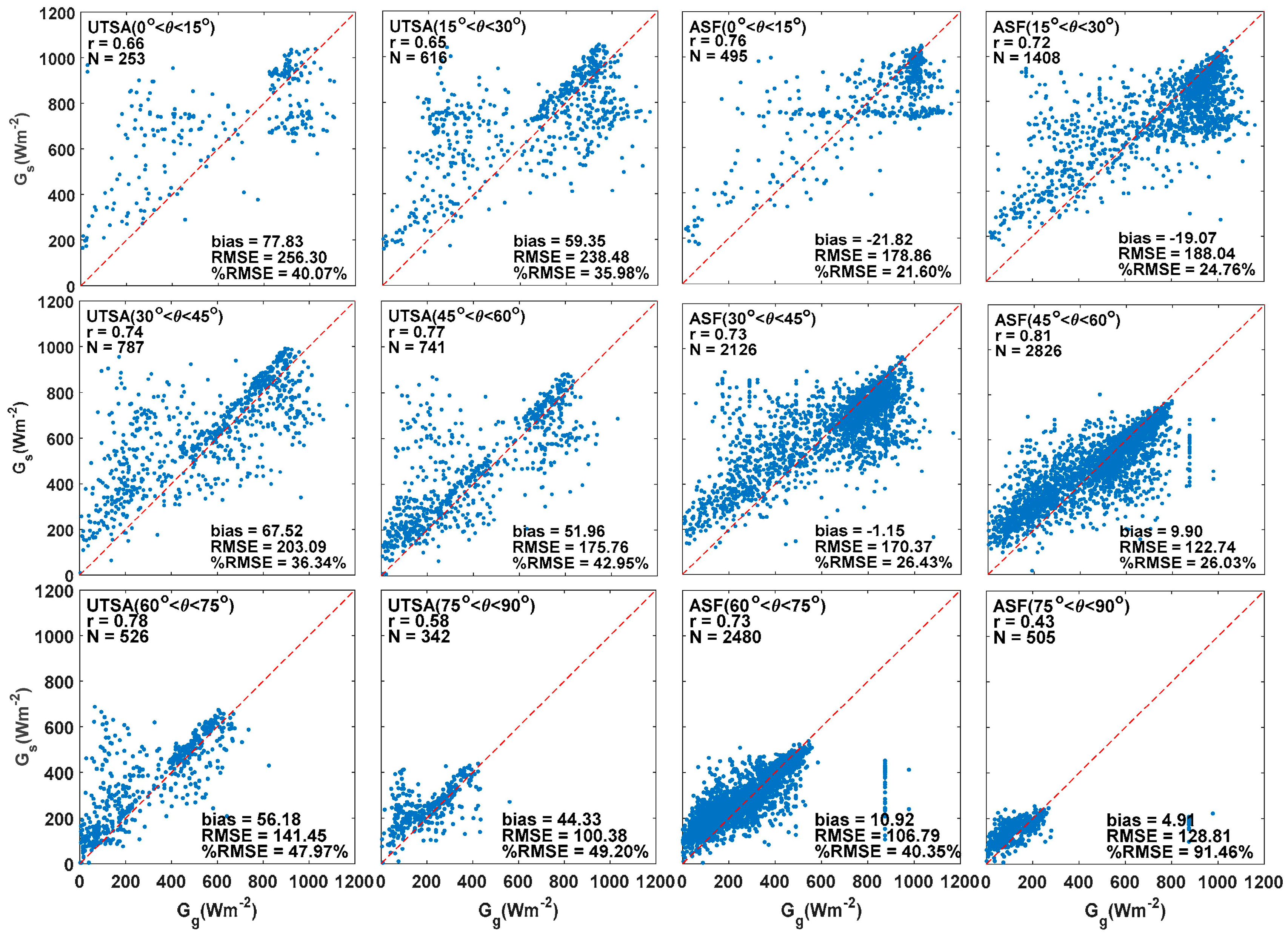

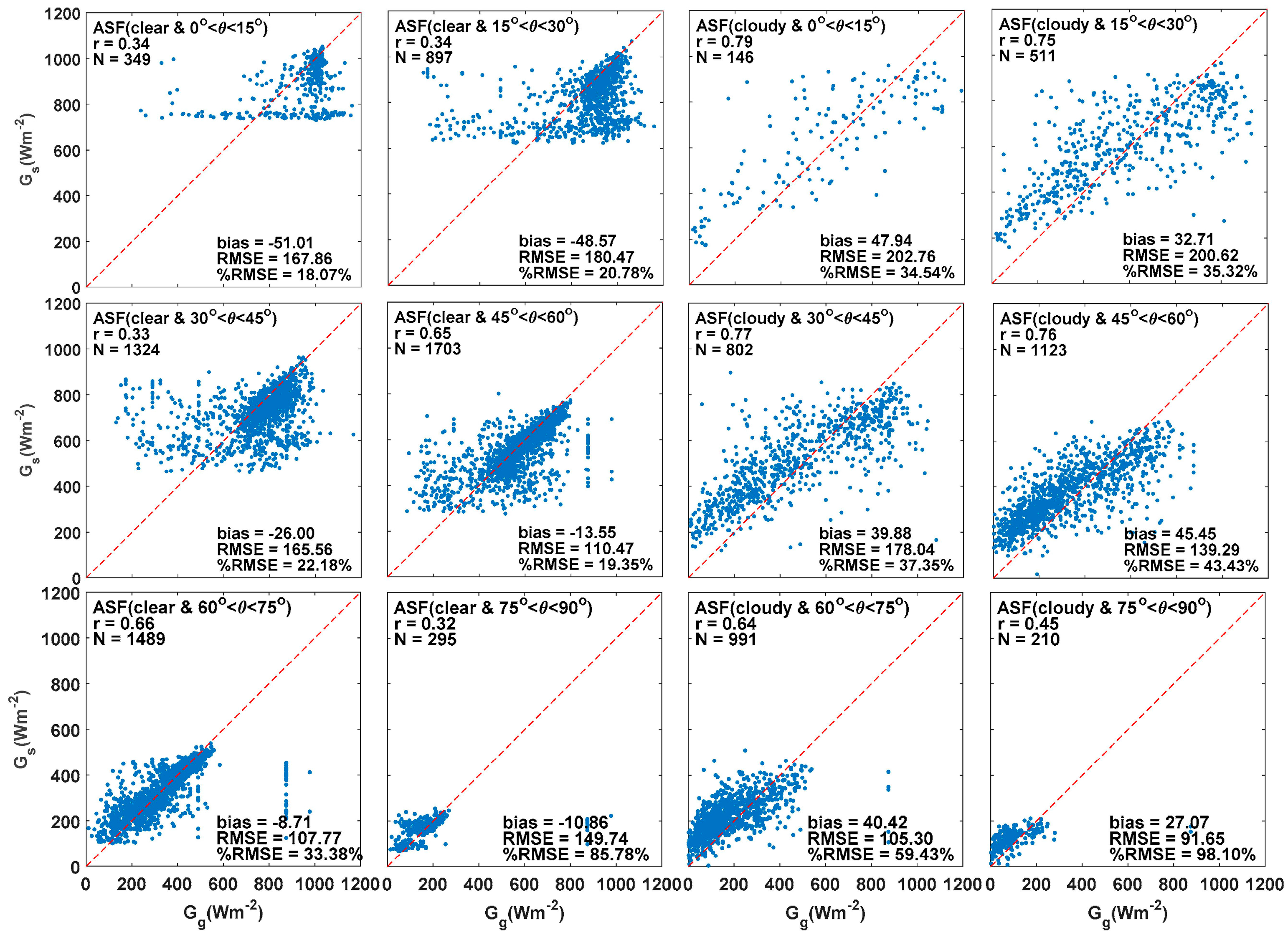
| Cloud Category | Classified ID | Description |
|---|---|---|
| Cloud type | 0 | Clear |
| 1 | partly (partly cloudy/fog) | |
| 2 | water(water cloud) | |
| 3 | mixed (supercooled/mixed-phase cloud) | |
| 4 | glaciated (optically thick ice cloud) | |
| 5 | cirrus (optically thin ice cloud) | |
| 6 | multi-layered(cirrus over lower cloud) | |
| Cloud layer | 1 | low (0–2 km) |
| 2 | mid (2–7 km) | |
| 3 | high (5–13 km) |
| Clear/Cloudy | UTSA | ASF | |||
|---|---|---|---|---|---|
| N | Percentage (%) | N | Percentage (%) | ||
| clear (0) | 2153 | 65.94 | 6057 | 61.50 | |
| low | partly (1) | 37 | 1.13 | 121 | 1.23 |
| water (2) | 242 | 7.41 | 941 | 9.56 | |
| mixed (3) | 19 | 0.19 | |||
| cirrus (5) | 91 | 2.69 | 348 | 3.54 | |
| mid | partly (1) | 20 | 0.61 | 67 | 0.68 |
| water (2) | 167 | 5.11 | 435 | 4.42 | |
| mixed (3) | 56 | 1.72 | 223 | 2.26 | |
| cirrus (5) | 119 | 3.65 | 466 | 4.74 | |
| high | partly (1) | 7 | 0.22 | 20 | 0.20 |
| water (2) | 3 | 0.09 | 2 | 0.02 | |
| mixed (3) | 324 | 0.98 | 156 | 1.59 | |
| glaciated (4) | 62 | 1.90 | 120 | 1.22 | |
| cirrus (5) | 197 | 6.03 | 669 | 6.80 | |
| multilayered (6) | 79 | 2.42 | 197 | 2.00 | |
© 2017 by the authors. Licensee MDPI, Basel, Switzerland. This article is an open access article distributed under the terms and conditions of the Creative Commons Attribution (CC BY) license (http://creativecommons.org/licenses/by/4.0/).
Share and Cite
Xia, S.; Mestas-Nuñez, A.M.; Xie, H.; Vega, R. An Evaluation of Satellite Estimates of Solar Surface Irradiance Using Ground Observations in San Antonio, Texas, USA. Remote Sens. 2017, 9, 1268. https://doi.org/10.3390/rs9121268
Xia S, Mestas-Nuñez AM, Xie H, Vega R. An Evaluation of Satellite Estimates of Solar Surface Irradiance Using Ground Observations in San Antonio, Texas, USA. Remote Sensing. 2017; 9(12):1268. https://doi.org/10.3390/rs9121268
Chicago/Turabian StyleXia, Shuang, Alberto M. Mestas-Nuñez, Hongjie Xie, and Rolando Vega. 2017. "An Evaluation of Satellite Estimates of Solar Surface Irradiance Using Ground Observations in San Antonio, Texas, USA" Remote Sensing 9, no. 12: 1268. https://doi.org/10.3390/rs9121268
APA StyleXia, S., Mestas-Nuñez, A. M., Xie, H., & Vega, R. (2017). An Evaluation of Satellite Estimates of Solar Surface Irradiance Using Ground Observations in San Antonio, Texas, USA. Remote Sensing, 9(12), 1268. https://doi.org/10.3390/rs9121268





